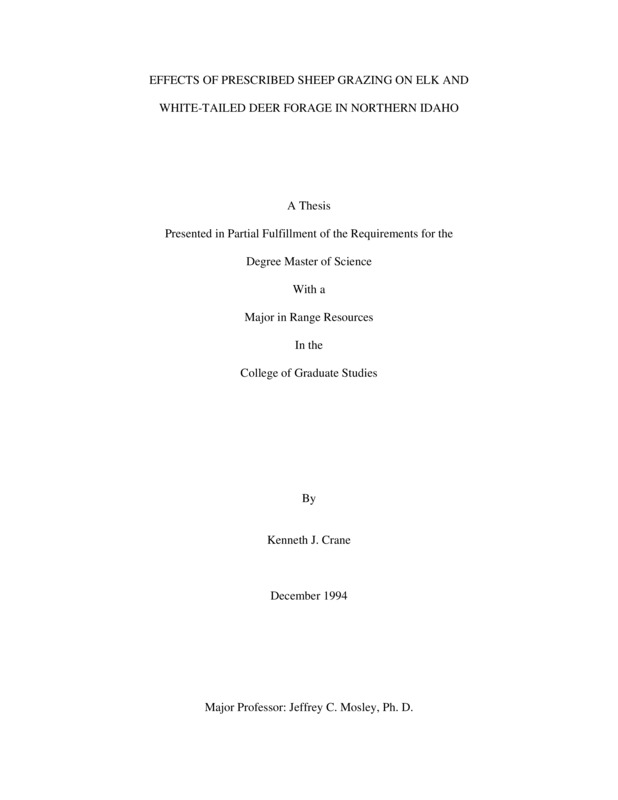PDF PREVIEW
Effects of Prescribed Sheep Grazing on Elk and White-Tailed Deer Forage in Northern Idaho Item Info
- Title:
- Effects of Prescribed Sheep Grazing on Elk and White-Tailed Deer Forage in Northern Idaho
- Creator:
- Crane, Kenneth J.
- Date Created:
- 1994-12
- Description:
- Effects of prescribed levels of sheep herbivory were examined on the quantity and quality of ungulate forage within a 4-year-old conifer plantation. The study site was divided into six 0.75-ha pastures and grazed at 6 prescribed levels of sheep herbivory during the summers of 1991 and 1992. Current year’s standing crop of shrubs and herbs was clipped within each of the 6 pastures. Species composition was estimated using the dry-weight-rank method. Vegetation was sampled in September (Fall) 1992, November (Winter) 1991, and 1992, and May (Spring) 1992 and 1993. Residual standing crop (RSC) remaining at the end of the grazing seasons within each of the 6 pastures varied from 278-2267 kg ha-1 in 1991, and 731-3016 kg ha-1 in 1992. Grab samples of all plant species were analyzed for crude protein (CP), available CP, neutral detergent fiber, acid detergent fiber, and acid detergent lignin. Regression analysis was used to compare the effects of sheep herbivory on forage quality and quantity for white-tailed deer (Odocoileus virginianua ochrourus) and elk (Cervus elaphus nelsoni). Summer sheep grazing at the levels administered in this study generally reduced the quantity of forage available to elk and white-tailed deer. Fall regrowth did occur in both years of the study, but did not compensate for forage removed by sheep. Summer sheep grazing reduced shrub standing crop the following spring in both 1992 and 1993, but herb production was increased as RSC decreased. Despite the reductions in standing crop, however, there was adequate standing crop to meet intake requirements for both elk and white-tailed deer. Forage quality was improved by sheep grazing in fall, but was generally decreased in the winter and late spring. Crude protein requirements for maintenance (5%) for both deer and elk were met in all treatments in Fall 1992, all in Winter 1991-92 except the 744 kg ha-1 RSC treatment, but only the 731 and 1042 kg ha-1 RSC treatments met this requirement for the Winter 1992-93. Crude protein requirements for the healthy adults in spring (12%) were met in all treatments in Spring 1992, and all but the 731 and 1042 kg ha-1 RSC treatments in Spring 1993.
- Document Type:
- Thesis
- Library Call Number:
- SF371.52.I2C72 1994
- Subjects:
- Flat Creek ungulates sheep grazing forage browse white-tailed deer forage elk forage prescribed grazing wildlife biology
- UIEF Unit:
- Flat Creek
- Location:
- UIEF; Flat Creek
- Latitude:
- 46.851013
- Longitude:
- -116.724478
- Department:
- Department of Wildlife
- Type:
- Text
- Format:
- application/pdf
Source
- Preferred Citation:
- "Effects of Prescribed Sheep Grazing on Elk and White-Tailed Deer Forage in Northern Idaho", UIEF Research Exchange, University of Idaho Library Digital Collections, https://www.lib.uidaho.edu/digital/uief/items/uief_0095.html
Rights
- Rights:
- In copyright, educational use permitted.
- Standardized Rights:
- http://rightsstatements.org/vocab/InC-EDU/1.0/

